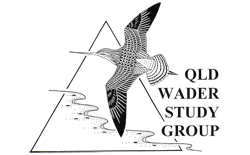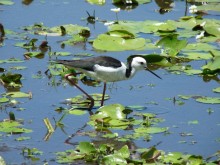Site Information:
Redcliffe Peninsula is located at the northern end of Moreton Bay and is bound by Hays Inlet to the south and Deception Bay to the north. The coastline is rocky in many places, providing suitable habitat for three specialities of the area, Ruddy Turnstone, Sooty Oystercatcher and Wandering Tattler. Common Tern is also likely to be seen along the entire coastline, but especially at Redcliffe Point between November and December. Redcliffe Peninsula is a popular destination for picnics, boating, swimming, fishing and other recreational activities so some disturbance can be expected, particularly on the weekend.
The northern end of the old Hornibrook Highway at Clontarf Beach is a good vantage point to observe waders feeding in Hays Inlet. Alternatively, one can walk onto the mudflats at the end of Haysmouth Parade. Species occurring here include Bar-tailed Godwit, Whimbrel, Eastern Curlew, Common Greenshank, Grey-tailed Tattler, Ruddy Turnstone, Great Knot, Red-necked Stint, Pied Oystercatcher and Pacific Golden Plover.
North of Hays Inlet, the next worthwhile stop is Pelican Park, Clontarf. The rock wall at the boat ramp is used as a high tide roost site if undisturbed by fishers. Species regularly occurring here include Curlew Sandpiper, Pied Oystercatcher and Pacific Golden Plover. Sooty Oystercatcher, both phases of the Eastern Reef Egret and the rare summer migrant, Wandering Tattler, are also sometimes seen. The rocky reefs out from the boat ramp warrant closer inspection on a falling tide.
About 2 km further along the Esplanade, the beach in front of Humpybong Yacht Club and Crockatt Park at Woody Point, as well as the rocky beach to the east of the jetty at Woody Point, are good spots to see waders during most times of the day.
Redcliffe Point and the rocky outcrop just off the point provide further opportunities to see Sooty Oystercatcher and, if the height of the high tide is below 2 m, Wandering Tattler. The rocky outcrops at Scarborough and Scotts Points are also worth inspecting for Wandering Tattler.
The wetland conservation reserve on the western side of Nathan Road, Redcliffe, is home to an impressive list of bird species, including the much sought after Latham’s Snipe and Painted Snipe. In a good wet season, many species of waterbird can also be seen, including Glossy Ibis, Black-necked Stork and occasionally, Brolga.
How to get there: Redcliffe Peninsula is located about 25 km north of Brisbane. To get there, drive north along the Gateway Motorway and about 14 km past the large roundabout to Brisbane Airport, take the Deagon Deviation. Follow this road for about 5 km to Clontarf, located on the opposite side of Hays Inlet. The rocky outcrops and points on the peninsula are reached by following the esplanades along the coastline.
To get to Nathan Road, travel to the northern end of the Houghton Highway, follow Elizabeth Avenue and then Anzac Avenue for about 7 km and turn right into Nathan Road. A sign to Redcliffe Airport marks this turn-off. The conservation reserve is about 500 m on the left.
Site coordinates: Haysmouth Pde: Lat 27º 15’ 46” S, Long 153º 04’ 34” E
Pelican Park, Clontarf: Lat 27º 15’ 40” S, Long 153º 05’ 05” E
Crockatt Park, Woody Point: Lat 27º 15’ 45” S, Long 153º 06’ 09” E
Jetty, Woody Point: Lat 27º 15’ 53” S, Long 153º 06’ 09” E
Redcliffe Point: Lat 27º 14’ 06” S, Long 153º 07’ 00” E
Nathan Road, Redcliffe: Lat 27º 12’ 44” S, Long 153º 04’ 18” E.
Amenities/access: Toilets and picnic facilities are located at several places along the peninsula foreshore. All of the above-mentioned sites except Nathan Road conservation area are easily accessible for disabled people.
Wader species: Latham’s Snipe, Bar-tailed Godwit, Whimbrel, Eastern Curlew, Common Greenshank, Grey-tailed Tattler, Wandering Tattler, Ruddy Turnstone, Great Knot, Red Knot, Red-necked Stint, Curlew Sandpiper, Painted Snipe, Pied Oystercatcher, Sooty Oystercatcher, Pacific Golden Plover, Masked Lapwing and Black-winged Stilt.
Other species: Glossy Ibis, Black-necked Stork and Common Tern (November to December).

